Copyright 2020 - 2021 irantour.tours all right reserved
Designed by Behsazanhost
A Travell to Susa city the Center of the Ancient Civilization
A Travell to Susa City the Center of the Ancient Civilization
Susa or Shush with more than 6,000 years old history in Khuzestan province with a complex of the best and unique ancient and historical monuments is registered in UNESCO’s list and is mentioned as one of the most important tourist sites in Iran. The city of Shush in the north of Khuzestan province is an ancient place. This ancient city was the center of the important civilization of the Elamites for hundreds of years and was the capital of this vast empire during the Achaemenid period. In the Sassanid period, Shush, along with Shushtar and Gondishapur, was considered the center of producing and exporting silk to other parts of the world. According to the ancient documents, this city is one of the most important and magnificent ancient cities of Iran and archaeological activities continued to be done in this place. The city was the capital of the Elamites, as well as the Achaemenid Empire's winter capital. Chogha Zanbil Ziggurat is regarded as one of its most important historic monuments, which is built on religious thought and one of the three Persian sites, along with Persepolis and Naqsh-e Jahan Square, which was first recorded in 1978 as the first Iranian national monument in the UNESCO World list. Orientalists believe that Chogha Zanbil is the first religious building in Iran and the largest ziggurat in the world.
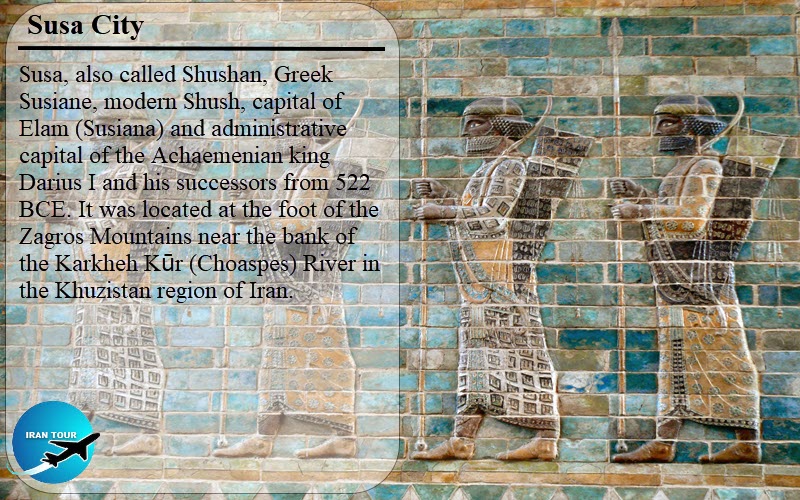 |
Why we should visit Susa?
- More than 6 thousand years of history.
- It is a precious UNESCO-listed World Heritage.
- One of the earliest human settlements in the world.
- Various historical, natural, and cultural sites in Susa.
- The biggest and most important Ilamit temple is located here.
- It was one of the most outstanding religious cities of the ancient world.
The first Elamite monarchy was formed in Shush in 3500 BC. At that time, people in Mesopotamia believed in polytheism and every city had its own god who protected him/her. People in the city center made a temple for their god in the form of a ziggurat. Chogha Zanbil was built by Untash-Napirisha, the great king of the Elam, in order to honor the guardian god of Shush around 1250 BC. The ziggurat and Elamite civilizations were devastated a few years after the building of this ziggurat by the invasion of the last king of the Assyrians.
A well-known geologist, Jacques de Morgan, reported that there were oil mines in the Chogha Zanbil area in 1890. After fifty years, an employee from New Zealand who was engaged in petroleum activities in Chogha Zanbil noticed a huge hill in a high place. He found an inscription buried beneath the ground. At the same time, an archaeologist group engaged in archaeological excavations within 35 km from Shush. Brown took the inscription to the group so that it might reveal the mystery of that hill, which was how the oil drilling revived the name of the Chogha Zanbil. Later, archaeological excavations were carried out by French archaeologist Roman Ghirshman, who extracted useful information from the soil between 1951 and 1962.
This huge temple is the largest architectural work left over from the Elamite civilization. It has a square-shaped architecture and is surrounded by circular fences. Its length and width are 105 meters and its height is 52 meters. It is made up of five floors and its height is 25 meters now although only two floors are available now. The four corners of this religious place are located in the four main directions, which indicates that the main directions were well-known at that time. It is made mostly by adobes. Because of this, bricks have been used to protect these adobes from erosion.
 |
In fact, thousands of bricks decorated the ziggurat. In this building, glazed bricks, bituminous mortar, gypsum plaster, and pottery studs have been used extensively. Also, during the excavation, the pottery and glazed sculptures of male cattle which were protected from the gates of the ziggurat were discovered. In the historical part of the National Museum of Iran, there is one of these cows which according to the king of Elam's order, was placed as a guardian of the northeast entrance gate of the Chogha Zanbil, which was made of vitrified clay and some Elamites words were written on its back.
There are cuneiform bricks on the walls of the temple, indicating the name of the king and his objective for building the temple. In addition, there are two separate circular platforms and different views expressed about them on the main floor. Some believe that they are altars and others relate them to astronomy and some of them are altars, and others are related to astronomy and solar clock. In the Louvre Museum, there is a table called the Bronze Victim Table, which is likely to belong to this place. There are two snakes and five women around this table. The precision and elegance used in making this table depict the great skill of Elamite metalworkers.
The water supply to Chogha Zanbil is one of the wonderful masterpieces in this temple. The Dez River runs from the nearby Chogha Zanbil. Because this river erodes the plain and the river level is lower than the plain, using its water was impossible for the people in the region. Therefore, the Elamite king Untash-Napirisha ordered to build off a 45-kilometer canal to reach the Karkheh River, which is at the same level as Chogha Zanbil. After passing the Haft Tepe, the water reached Chogha Zanbil although it pours and settles into the big and small ponds because the Karkheh water is muddy after passing the Khuzestan plain. The water is purified by Pythagoras's laws after passing through water pipes. Perhaps, it is one of the oldest refineries in the world.
What to see in Susa?
Khuzestan is one of the most important tourist provinces of Iran in terms of the number of tourist attractions. Among the various amazing cities, Susa is a must-see place. The unique and valuable historical, natural, and cultural monuments fascinate and satisfy all kinds of travelers.
The most famous places in Susa are:
Historical monuments: Tchogha Zanbil (Elamite Temple), Apadana Castle Shush (Achaemenian Era), The ancient site of Susa, The ancient hill of the Acropolis, Shaouer Palace (Palace of Ardeshir II, Sassanid Era), Haft Tepe ancient site.
Islamic monuments: Susa Mosque, the mausoleum of Debal Khazai
Jewish Temple: Danial Nabi mausoleum
Cultural sites: Susa Museum, Susa castle, or French castle.
Natural sites: Karkheh National Park, Shaouer River, Bamdej Lagoon, Mish Dagh protected area
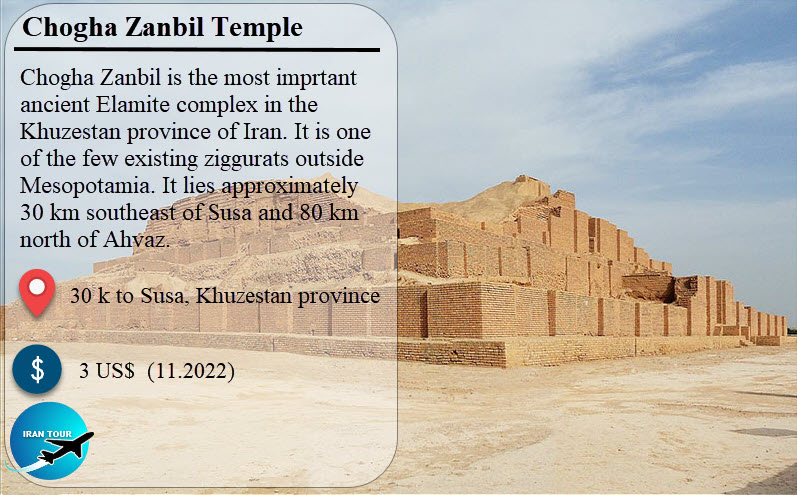 |
Tchogha Zanbil. Khuzestan Province
Tchogha Zanbil is an ancient sanctuary built at the time of Ilam (Elamites) and about 1250 BC. Tchogha Zanbil is a part of the city of Dur Untash, located near Shush or Susa (ancient city) in Khuzestan province. In 1979, this structure was the first Iranian monument to be listed on the UNESCO World Heritage List. It has exceptional and universal value. The Orientalists considered the Tchogha Zanbil as the first Iranian religious building. The ziggurat(Tchogha Zanbil) considered being the best-preserved example of a stepped pyramidal monument by UNESCO In 1979, Chogha Zanbil became the first Iranian site to be inscribed on the UNESCO World Heritage List.
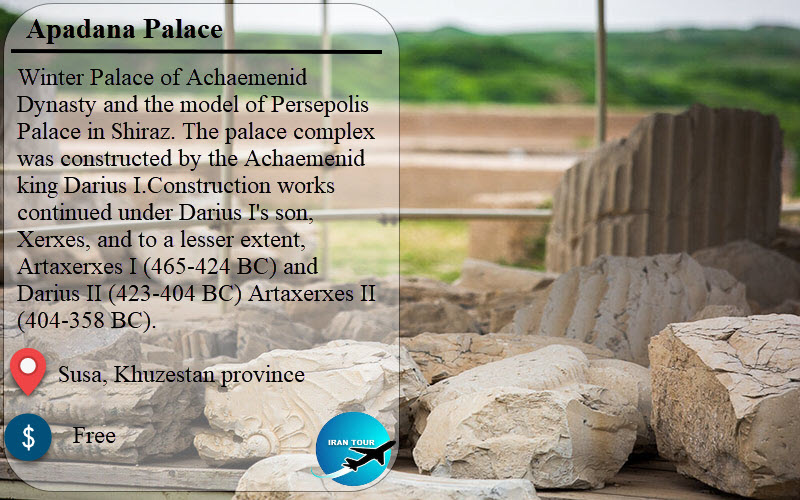 |
Apadana Palace
The winter capital of the Achaemenian dynasty was built by the order Darius I (550-486 BC) who built it over the ruins of an older Elamite structure around 521 BC to 515 BC. The Achaemenids replicated it in Persepolis but on a larger scale. This great palace included 100 different rooms, an audience hall, 6 different courtyards, a harem, and a gate. The walls of the palace were decorated with glazed bricks bearing images of twelve-petal lotus flowers, the Immortals (Imperial Guards), and winged lions.
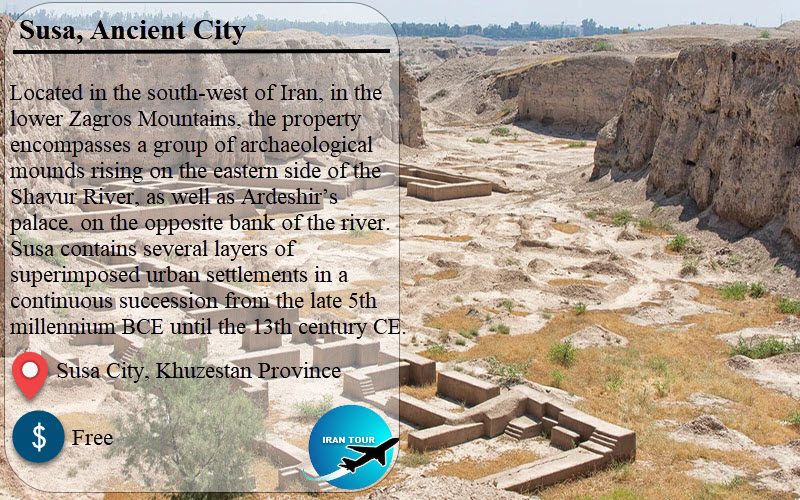 |
The ancient city of Susa
The ancient city of Susa is considered one of the oldest human settlements in the world with a history of over 6000 years listed by UNESCO. According to documents and evidence from ancient times, Susa was one of the major Iranian cities known for its magnificence. ;.
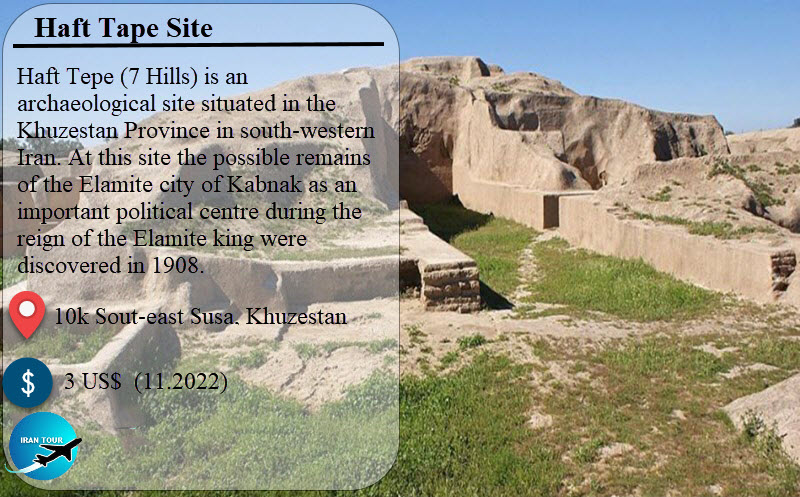 |
Haft Tepe
An archaeological site about 10 km southeast of Susa in Khuzestan province. They are 7 hills or Tepes forming an imposing mass rising about the Susa plain. This site has 4 important main hills. The largest rises about 17 m above the surrounding plain which, with its related extensions, covers an area about 1500 m long and 800 m wide. Architectural remains so far uncovered include the Tomb Temple Complex, a fired-brick royal tomb with a barrel-vaulted roof, and another fired-brick subsidiary tomb also with a vaulted roof, now collapsed, both attached to a large sun-dried brick temple. brick with two parallel rooms opening onto a large portico which in turn opens onto a large courtyard paved with several layers of baked bricks.
Susa Mosque
A first-century AH mosque founded on the ancient Shoosh hillock. This is one of the early Islamic mosque plans, which has a central courtyard with four naves and pillared porticoes around the courtyard. The walls were of sun-baked brick. The large pillared hall and the brick inscriptions in Kufic script were discovered in the southeastern part of the courtyard.
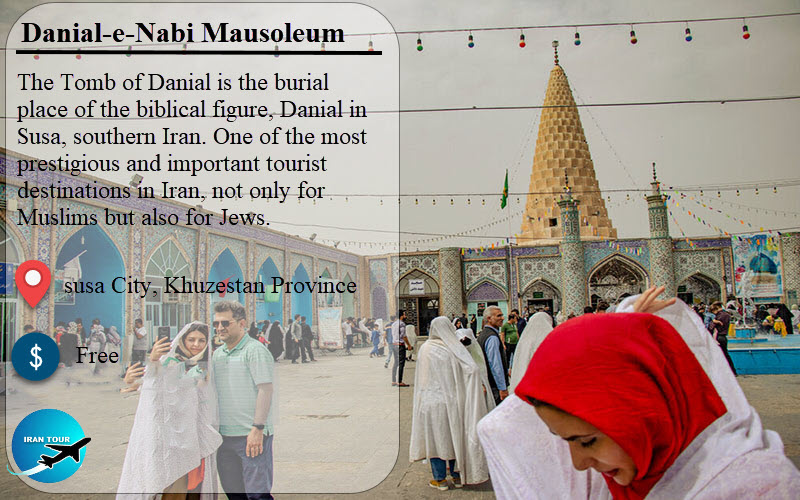 |
Danial Nabi Mausoleum
One of the most important Jewish mausoleums resting abode of one of the prophets of the Israelites who is venerated in Islam although not mentioned in the Qur'an. The Tomb of the Prophet Daniel is the traditional burial place of the biblical prophet Daniel. Various locations have been named for the site, but the tomb at Susa, Iran (Persia) is the most widely accepted, first mentioned by Benjamin of Tudela, who visited Asia between 1160 and 1163.
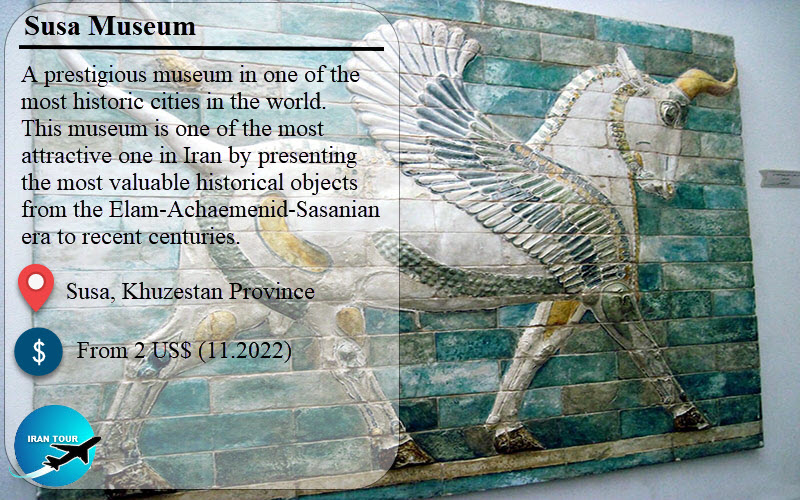 |
Susa Museum
A museum made of ancient and historical bricks discovered in the Susa area. A valuable museum with unique objects from 6000 years ago situated in a garden in the vicinity of Susa Great Castle(French castle) and opposite the Danial-e-Nabi mausoleum in Khuzestan Province. The museum was inaugurated in the year 1966 to display remnants from the pre-Elamite to the Islamic period and has some unique objects. The shush Museum has two big halls and all exhibition works are the results of digs in the Shush and Chughazanbil regions. The other objects consist of statues, artifact capitals of Suleiman Mosque, and Shush's Apadana.
 |
Susa Castle
One of the most famous historical castles in Iran and the most remarkable monument of Susa city was made by French archaeologist Jacques de Morgan in 1912 on the historical hills, Acropol, near the tomb of Daniel as a residence for French archaeologists. Its design is inspired by medieval European castles and has some similarities to the French prison of the Bastille. The castle was built with bricks from Apadana Palace and some bricks from Chogha Zanbil with cuneiform inscriptions. In the architecture of Susa Castle, you can easily see a fusion of Iranian and European architecture. Shush Castle has two large courtyards - three entrances - two floors and several rooms that were used as guards' rooms - restrooms and storage places for historical objects.
 |
Getting there?
If you are going to travel to this historical city, you can use public Buses, trains, or air travel as follows:
- There are various public Buses from Tehran or the main cities to Ahvaz ( on the way to Ahvaz the cities of Dezfoul & Andimeshk are the closest cities to Susa), and you can take a Taxi from Dezfoul or Andimeshk to Susa.
Andimeshk to Susa 40 km (Taxi rate = One way 1 US$)
Dezfoul to Susa 35 km (Taxi rate = One way 1 US$)
Tehran to Ahvaz(VIP Buses): From 8 US$
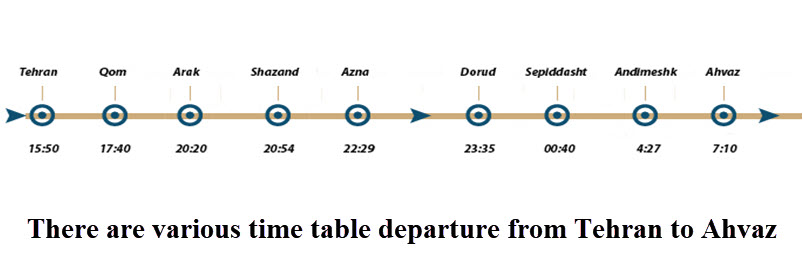 |
- Your next option is the train.
There are various timetable departures from Tehran to Ahvaz.
It takes about 16 hours from Tehran to Ahvaz. You can leave the train at Haft Tepe station and take a Taxi to Susa, while you can visit Haft Tepe historical site and museum.
Haft Tepe to Susa is 30 km.
Train ticket from Tehran to Ahvaz: 15 US$ (11.2022)
- The last and fastest option is a flight from Tehran to Ahvaz then take a taxi to get Susa. It takes one hour and 27 minutes by car.
Where to stay?
You have various choices to stay in Sush or Dezful city.
You can choose one of the hotels (1 to 3 stars) or one of the eco-tourist accommodations in Shush or Dezful(35 km to Susa).
Please contact us for more information about booking a hotel.
- Details
- Category: Where to go in IRAN